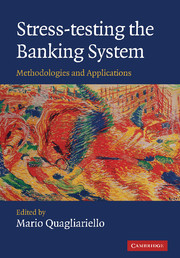Book contents
- Frontmatter
- Contents
- List of figures
- List of tables
- List of boxes
- List of contributors
- Foreword
- Acknowledgements
- Introduction
- Part I Fundamentals
- Part II Applications
- 8 Stress-testing credit risk: the Italian experience
- 9 Stress-testing US banks using economic-value-of-equity (EVE) models
- 10 A framework for integrating different risks: the interaction between credit and interest rate risk
- 11 Stress-testing linkages between banks in the Netherlands
- 12 An integrated approach to stress-testing: the Austrian Systemic Risk Monitor (SRM)
- 13 From macro to micro: the French experience on credit risk stress-testing
- 14 Stress-testing in the EU new member states
- 15 Cross-border macro stress-testing: progress and future challenges for the EU
- 16 Stress-testing at the IMF
- Conclusions
- Index
- References
15 - Cross-border macro stress-testing: progress and future challenges for the EU
from Part II - Applications
Published online by Cambridge University Press: 18 December 2009
- Frontmatter
- Contents
- List of figures
- List of tables
- List of boxes
- List of contributors
- Foreword
- Acknowledgements
- Introduction
- Part I Fundamentals
- Part II Applications
- 8 Stress-testing credit risk: the Italian experience
- 9 Stress-testing US banks using economic-value-of-equity (EVE) models
- 10 A framework for integrating different risks: the interaction between credit and interest rate risk
- 11 Stress-testing linkages between banks in the Netherlands
- 12 An integrated approach to stress-testing: the Austrian Systemic Risk Monitor (SRM)
- 13 From macro to micro: the French experience on credit risk stress-testing
- 14 Stress-testing in the EU new member states
- 15 Cross-border macro stress-testing: progress and future challenges for the EU
- 16 Stress-testing at the IMF
- Conclusions
- Index
- References
Summary
Introduction
As seen in the previous chapters, macro stress-testing has become an integral part of the financial stability assessment work being carried out by many central banks around the world. Within the European Union (EU), the process of financial integration, particularly intense within the euro area, is leading to a greater degree of interconnectedness between national financial systems. Although this interconnectedness creates a strong case for conducting macro stress tests which take account of cross-border dimensions, progress in this area has been relatively slow for at least two main reasons. The first reason is practical: there is a paucity of harmonised data across countries with sufficient time spans to allow for quantitative assessment of the relevant sources of risk and exposures. The second reason is institutional: the national responsibility for financial supervision in the EU means that the scope for sharing information across institutions and on a cross-border basis may be limited by national practices and legal restrictions.
Undoubtedly the greatest methodological advances in macro stress-testing have been made in the area of quantification of credit risk. An important reason for this is that effective management of credit risk is paramount for commercial banks. As concerns cross-border linkages across banking sectors, two main channels for credit risk can be distinguished: common exposures to the same (or systemic) sources of risk and balance sheet linkages between institutions.
- Type
- Chapter
- Information
- Stress-testing the Banking SystemMethodologies and Applications, pp. 278 - 296Publisher: Cambridge University PressPrint publication year: 2009



